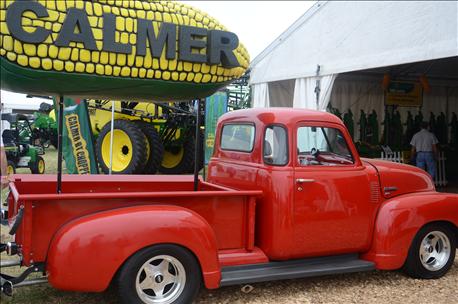
Just how fast is agriculture changing? Fast enough that many things you once saw at farm shows aren’t there anymore. In their place are technologies that make thing faster, more efficient and more productive- or so they say.
Here is my list of 10 things I would be hard pressed to find in my yearly visit. Perhaps they will be there somewhere, but finding them would be difficult.
10. Scythe to mow weeds

YOU WON'T FIND THIS TRUCK EITHER: At least not for sale - we found this classic pickup at the Calmer Cornhead exhibit at the Farm Progress Show.
I’ll be able to find weed eaters, lawn mowers and all sorts of tools that cut weeds. But an old-fashioned scythe that must be swung by hand? Doubtful. That was what we used to cut weeds under our electric fences back in the day on the dairy farm. It was before the days of gas-powered weed-cutters.
9. A three-wheel all-terrain vehicle
OK, there may still be come around. But for safety reasons amongst others, the push is toward four-wheel ATV’s and UTV’s, or utility vehicles. You will find plenty of them. Our Farm Progress New Products crew found a dozen new models of ATV’s at the 2015 Farm Progress Show.
8. An honest –to-goodness tractor brochure in print form!
Some companies will still have them. But more would just as soon you take a DVD to learn about their products. And if you’re a media person like me looking for new products, even if they have literature available, they almost insist I take a DVD too. Just give me good, old-fashioned printed brochures. How else will my son collect literature 50 years from now, like I do on tractors from the 1960’s?
7. Ropewicks to control weeds in corn and soybeans.
We’re talking about long wick-like ropes, often in a tube on a wheel carrier, to pull through the field and wipe weeds above the crop with glyphosate. Yes, you may find one, but it‘s likely marketed in southern states primarily for control of weeds in pastures. Gone are the days when glyphosate couldn’t be sprayed over the top on crops. In fact, this technology is so out-of-date that the glyphosate boom for spraying over Roundup Ready corps has peaked. Resistant weeds took care of that one.
6. A small square hay baler.
You will no doubt find one or two, but go to the major manufacturers and see what kind of baler they’re displaying. Odds are good you’ll find far more big round balers and big square balers than small square balers. It’s all about a changing workforce and less labor-intensive methods of handling hay.
5. The hay stacker- and it’s not a trick question
Yes, you will find stacks that accumulate and stack small square bales. We’re talking about the huge machine that stuffed an almost forage-sized wagon load of corn stalks into one big rectangular stack, and then exited it out the back. It was technology that fit a need, but not everywhere in the country, and not for very long.
4. An old-fashioned metal corn planter plate for planting seed corn.
It was the heart of the John Deere 494-A planter, which was quite the innovation in its day. Plates for vacuum planters don’t count- find us the old-fashioned kind, and not at an antique booth!
3. A garden tractor without a hydrostatic transmission.
If you want a garden tractor with a true put it in gear and shift, rather than depress the pedal and go, you’re going to look hard, at least at the farm show. You might have better luck at a big box farm store that appeals to people wanting a low-priced tractor.
2. A hay conditioner - not a mower-conditioner
This has to be one that only conditions hay. Many companies jumped into making them in the late ‘50’s and early ‘60s when farmers still cut hay with sickle bars but wanted it to dry faster. As a matter-of-fact, you might be hard pressed to find a new sickle-bar mowing machine at the show!
1. A 1949 Massey Harris tractor!
Got you on this one! You won’t even to be able to find a Massey Ferguson tractor made by Massey Ferguson. You can find quality Massey-Ferguson equipment, but it’s made by AGCO, not the original company that formed from the merger of Massey-Harris and Ferguson decades ago.
I have one, but you couldn’t even find it in my tool shed right now. It’s at the Delphi High School Ag Shop, being restored. And today I find out the crew, all high school boys, redoing it want to add a chrome stack! Try to find a ’49 Massey with a chrome stack anywhere!
About the Author(s)
You May Also Like




